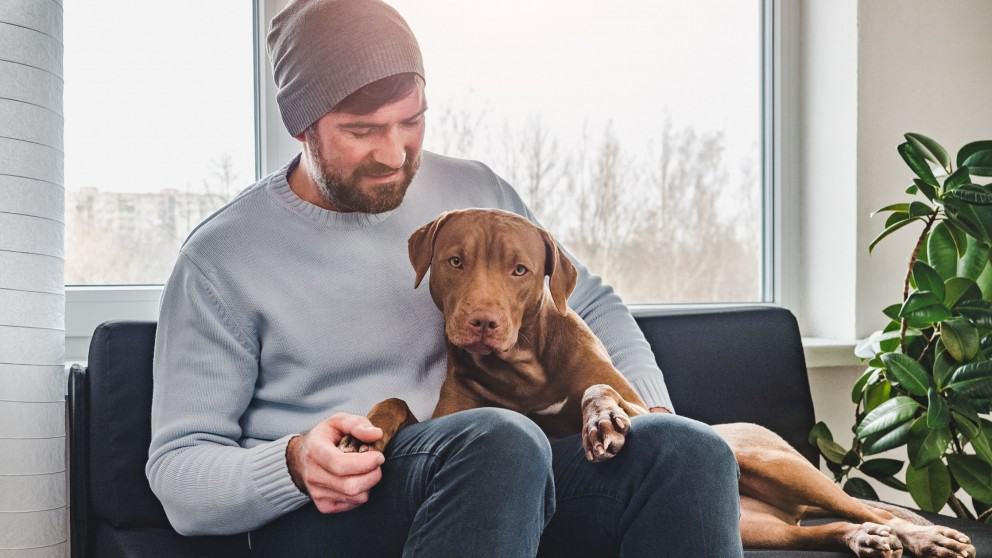Bully Dog: What You Need to Know About Adopting a ‘Bully Breed’

Updated November 11, 2025
Tail wagging, tongue flapping, and enthusiastic kisses are just a few of the heartwarming reactions you can expect to come home to when you adopt a bully breed. These sturdy, active dogs make wonderful companions that will fill your life with loyalty and love. The overall impression that bully breeds give is one of confidence and power, with their strong stance and alert movement often leaving a lasting impression on those who meet them for the first time.
Unfortunately, unaware pet owners sometimes relinquish their bully breeds to shelters because they didn’t realize the commitment required to own such a dog. Before bringing a bully breed into your life, it’s important to be aware of all the facts about these remarkable dogs. Are they good with children and other people? How much time and attention do they really need? These are just a few important questions that should be pondered when considering adopting a bully breed, and we’re here to help you find the answers.
Understanding Bully Breed Anatomy: Separating Fact from Fiction
Dr. I. Lehr Brisbin of the University of Georgia researched pit bull mixes and a variety of similar breeds, concluding that they have the same anatomy as any other dog, including that of a teacup Chihuahua.
Bully breeds are recognized for their broad, well-defined head, a well-proportioned muzzle, and a smooth, short coat, all of which are important features in breed standards. They are also known for their impressive muscular mass and solid stock. Well-developed shoulders contribute significantly to their powerful movement and upright posture, which are key aspects of their conformation. Altogether, these features create a striking picture of strength and stamina that makes the bully breed’s physical presence so impressive; underneath that powerful exterior lies a gentle companion.
Exercise Needs: Keeping Your Bully Breed Happy and Healthy
As is true with most other dogs, a bored bully can become a destructive bully, and we want to help you avoid that situation entirely. If you prefer a slow-paced lifestyle and quiet evenings with minimal activity, it may be best to consider other breeds. Also, remember that you should never have your bully breed off-leash in public for their safety and the comfort of others, so finding open spaces where he can run free might pose a challenge that requires creative solutions.
If you don’t have a fenced-in yard but have available space, a dog run makes an excellent option, as does a doggie treadmill for those rainy days or extreme weather. Remember to supervise all of your dog’s activities to ensure their safety and well-being. Bully breeds benefit from exercise that encourages straight movement and helps develop strong shoulders. Their powerful build keeps them close to the ground during activity, making them naturally athletic.
Most bully breeds will thrive in an apartment and can succeed in an urban setting as long as they receive plenty of exercise and at least 30 minutes of outdoor activity daily, although more is always beneficial for their physical and mental health. Pit bull mixes are especially notorious for escaping, so if you have a fenced-in yard for playtime, make sure it’s secure and that there aren’t any loose boards your bully could use as an escape route. Consider the height of your enclosure as well, since some bully breeds are excellent jumpers.
Health Considerations: What to Expect with Your Bully Breed
Providing the best care for a bully breed doesn’t differ much from caring for any other breed, which should give you peace of mind. They all require annual veterinary exams and vaccinations, and should be fed a healthy diet on a regular schedule to maintain their muscular physique and overall well-being. These breeds are typically very fit with few health concerns, though they are predisposed to certain conditions.
Joint problems are a common issue some bully breeds might face due to their highly active nature and stocky build. Monitoring your dog’s height at the withers and at the point of the shoulder can help track healthy growth and conformation, which is important for identifying potential joint or skeletal issues early before they become serious. To minimize the risk of future complications and protect your bully’s joints, try to walk your dog on dirt or grass, as asphalt can be harder on joints over time.
Insurance and Housing Considerations: Planning Ahead
The annual cost of owning a bully breed will be about the same as with any other dog, plus a few extra considerations. Before you adopt, find out if your homeowner’s insurance includes an exclusion on pit bull mixes or other breeds; you may need to pay an additional premium to call one of these dogs part of the family. Some insurance policies are influenced by reports of incidents involving bully breeds, although responsible ownership significantly reduces these risks. Likewise, if you rent, check with your landlord to make sure you can have a bully breed in your building before falling in love with a dog you can’t bring home.
The Adoption Process: What to Expect When Bringing Home a Bully Breed
Any reputable shelter will put you through a thorough screening process before allowing you to adopt a dog, but the process is usually more rigorous for someone looking to take home a bully breed. After you’re approved, the adoption fee is typically collected; this fee usually covers spaying or neutering, vaccines, and microchipping, and is most often paid by credit or debit card.
Don’t be offended if a shelter questions your motives in adopting pit bull mixes and other breeds with a history of abuse or dog fighting. Shelters could request a list of references along with a home visit to see where your adopted bully will live, ensuring they’re placing dogs in safe, appropriate environments. You should also be prepared to answer a detailed questionnaire in which you will be asked things like why you want to adopt a bully breed and your history as a pet owner.
Many cities and counties have laws regarding dogs, but due to fear and irresponsible pet ownership, some local governments have enacted breed-specific legislation (BSL) to address perceived issues with bully breeds. The easiest way to find out if your town has passed BSL is to contact your local animal control facility. The shelter where you plan to adopt should also be familiar with the regulations. However, if you’re adopting from out of town, it’s best to check for yourself first to avoid any potential legal complications.
Training and Socialization: The Key to a Well-Adjusted Companion
When it comes to American Bully dogs, training and socialization are essential for raising a happy, well-adjusted companion. Due to their strong-willed nature, American Bullies thrive with consistent guidance and positive reinforcement from their owners. They want to please you and respond beautifully to patient training. The United Kennel Club (UKC), which recognizes the American Bully as an official breed, highlights the importance of early socialization and training in its official UKC breed standard. Reputable breeders and responsible owners know that investing time in these areas is key to producing a gentle, loyal, and affectionate dog that brings joy to the family.
Starting training and socialization with puppies is especially important to ensure they develop proper behavior and social skills as they mature into their adult bodies. American Bullies have a unique history, having been developed from the American Pit Bull Terrier (APBT), the English Bulldog, and several other breeds. The APBT played a significant role in the development of the American Bully, influencing its temperament and physical traits. American Bullies were selectively bred for specific characteristics, including strength, companionship, and a stable temperament.
Crossing these breeds helped produce the unique traits that define the American Bully today, making them both powerful and people-oriented—perfect for active families or individuals who are aware of the breed’s characteristics and needs. With proper training, American Bullies can get along well with other dogs and become loving companions for both children and adults. Socialization from a young age helps ensure that your bully is comfortable in a variety of situations, reducing the risk of behavioral issues and helping them live harmoniously in the world around them.
The American Bully breed comes in several size categories, including the Classic and Pocket varieties that suit different lifestyles. The Classic American Bully has a lighter frame and less overall mass compared to the Standard, while still maintaining bully traits and a similar height at the withers. The Pocket American Bully is more compact, with a shorter height range but a strong, muscular build that packs impressive power into a smaller package.
Breed standards also specify typical size differences between males and females, with males generally being larger and heavier, while females tend to be slightly smaller and lighter. Additionally, the merle color pattern is considered a disqualifying trait in conformation shows for American Bullies, though it doesn’t affect their ability to be wonderful pets.
If you’re considering adopting an American Bully, it’s important to research both the breed and the adoption process thoroughly so you feel prepared and confident. Adoption fees for American Bullies can vary, but adopting from a rescue or shelter is often more affordable than purchasing a puppy from a breeder and gives a deserving dog a second chance at happiness. Additionally, adult dogs may already have some training and socialization, making the transition into your home smoother and less stressful for both you and your dog.
When searching for the right fit, look for organizations or breeders who follow the UKC breed standard and prioritize the health and temperament of their dogs above all else. It’s also important to note that the American Bully is a different breed from the American Bulldog or the American Pit Bull Terrier, even though they share some ancestry and physical traits. Each breed has its own unique temperament and requirements, so understanding these differences will help you find the perfect dog for your lifestyle and family situation.
The Staffordshire Bull Terrier, for example, was developed in Staffordshire, England, in the 19th century and is sometimes referred to as the ‘Pitdog’ or ‘Pitbull Terrier’ by enthusiasts, highlighting the complex history of these related breeds.
While American Bullies are recognized for their affectionate and loyal nature, their reputation in the media can sometimes interfere with adoption opportunities. In some countries, there are restrictions on owning American Bullies due to their perceived involvement in certain incidents. However, with responsible ownership, proper training, and socialization, these dogs can be wonderful companions who bring joy and affection to their families for many years.
Breaking Down Misconceptions: The Truth About Bully Breeds
American Bully dogs are often surrounded by misconceptions and stereotypes that can unfairly impact their reputation and adoption opportunities. One of the most persistent myths is that these breeds are inherently aggressive toward humans; however, the official UKC breed standard for the American Bully emphasizes a temperament that is affectionate, outgoing, and eager to please.
Another common stereotype is that bully breeds are difficult to train or lack intelligence. In reality, American Bullies are highly intelligent and thrive on positive reinforcement training. With consistent guidance and plenty of exercise, these dogs can excel in obedience and become well-mannered companions who make you proud. Their eagerness to learn and bond with humans makes them an excellent fit for active owners who are committed to training and socialization.
Media coverage has also played a significant role in shaping public perception of bully breeds. Stories often focus on negative incidents, which can lead to an undeserved negative reputation. It’s essential to note that the American Pit Bull Terrier, a parent breed of the American Bully, was once revered as a “nanny dog” for its gentle and protective nature around children.
It’s also essential to recognize that the American Bully is a distinct breed from the American Bulldog and the American Pit Bull Terrier, despite sharing some ancestry and a similar appearance. Each breed has its own unique breed standard, temperament, and care requirements. Understanding these differences is crucial when considering which breed is the right fit for your family and lifestyle, helping ensure a successful match.
When it comes to adoption, the adoption fee for American Bully dogs can vary depending on the organization and location. However, adopting from a reputable rescue or shelter often includes support and resources to help new owners successfully integrate their new companion into the family.
Ultimately, it’s essential to look beyond the misconceptions and stereotypes that surround bully breeds and see them for who they truly are. By focusing on their unwavering loyalty, boundless affection, and impressive intelligence, and providing them with proper training, exercise, and care, American Bullies and other bully breeds can become wonderful companions who enrich the lives of their owners in countless ways. Promoting awareness and education about these breeds helps ensure they receive the recognition, support, and loving homes they deserve.
The Reward: Super Loving Companions Who Will Steal Your Heart
Bully breeds are generally very loving and loyal companions who will become devoted members of your family. They normally form incredibly close bonds with their owners and will constantly want to be around your home, following you from room to room. These breeds won’t tolerate being relegated to the backyard or left alone for long periods; they need your presence and companionship to thrive emotionally.
Be prepared to commit at least two hours a day of undivided attention to your bully breed to ensure his happiness and well-being. Remember, you can’t judge an entire breed by a few negative news reports that don’t represent the vast majority of these wonderful dogs. If you’re ready to adopt a loving and active dog who will shower you with affection, you will have a faithful companion for life in a bully breed—a friendship that will reward you every single day.
With whatever breed you get, make sure you get all the coverage you need from pet insurance, even supplemental benefits that provide extra peace of mind. Keep your beloved pup happy, healthy, and protected!
Do you have a French Bulldog? Read this article to know more about their health issues and how to keep your furry friend comfortable and thriving.



